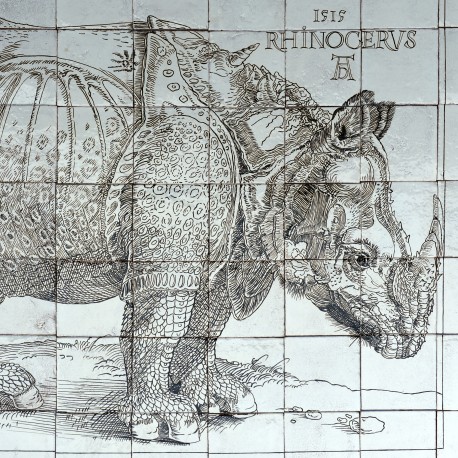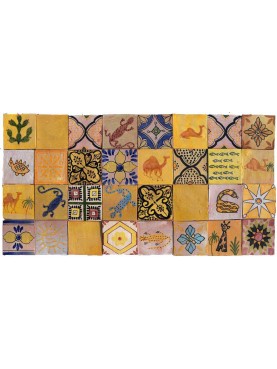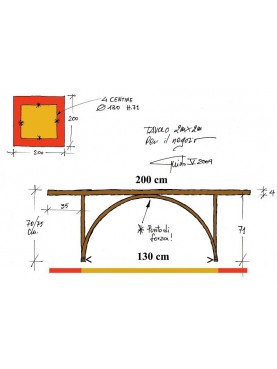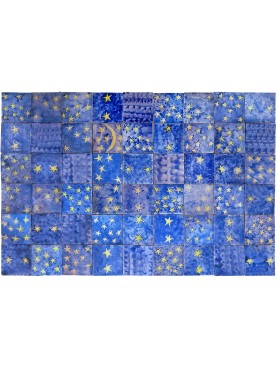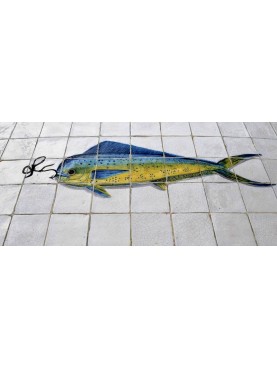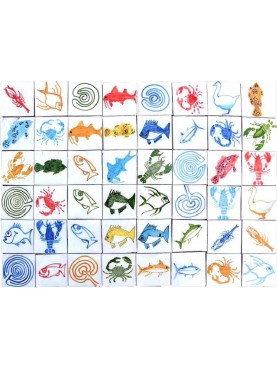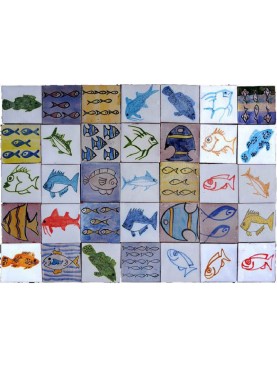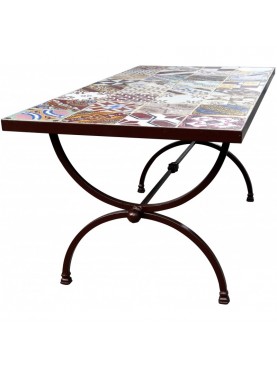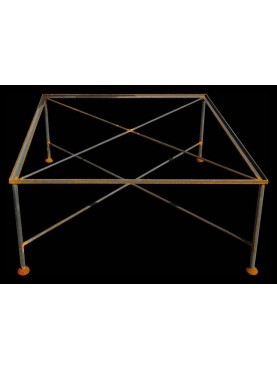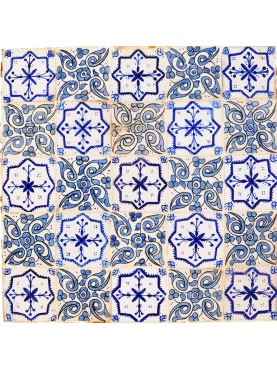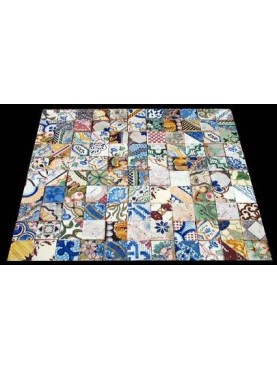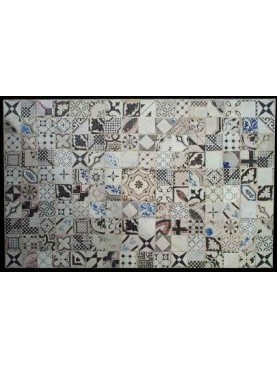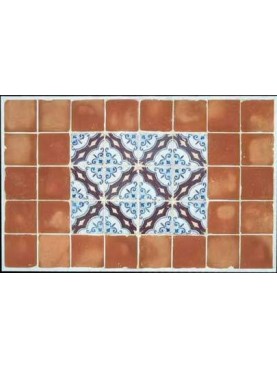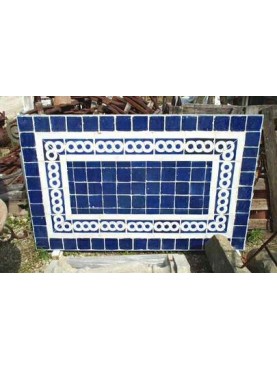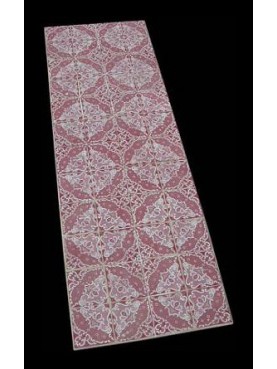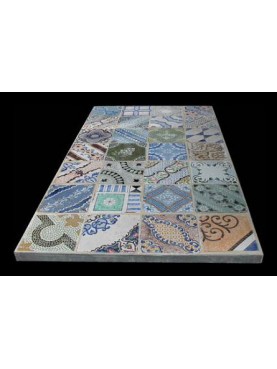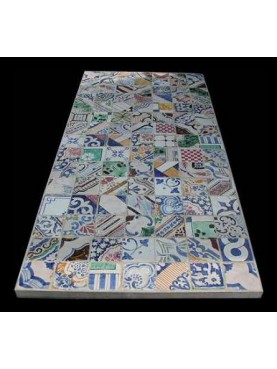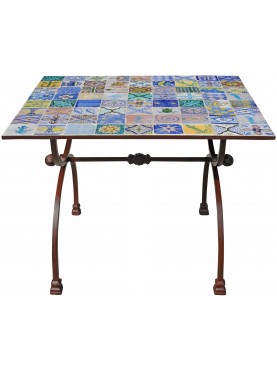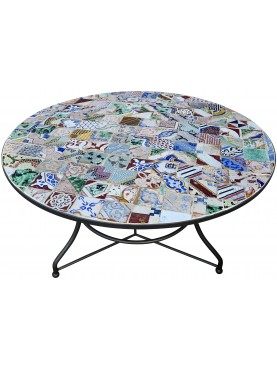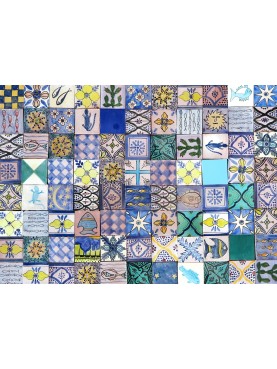Albrecht Durer rhino majolica tiles panel - 70 tiles
Albrecht Durer rhino majolica tiles panel - 70 tiles
12633
New
Reproduction of the famous woodcut of the Rhinoceros by Albrecht Durer 1515.
Original measurements of the drawing 23.5 x 29.8 cm, kept at the British Museum.
Our reproduction is made with 70 majolica tiles 15 x 15 cm. and measures L. 150 X H. 105 cm.
Our exclusive production.
We can make it in any dimensions.
Data sheet
| Height | 41.34 in | 105 cm |
| Width | 59.06 in | 150 cm |
| Thickness | 0.39 in | 1 cm |
| Weight | 70.55 lbs | 32 Kg |
| Artist / Creator / Architect | Albrecht Durer (Woodcut) | |
| Where the original is kept | British Museum (London) | |
| Historical period | 1515 | |
| Manufacturing | Recuperando srl | |
| Material | Majolica |
More info
Dürer's Rhinoceros is the name commonly given to a woodcut executed by German painter and printmaker Albrecht Dürer in 1515. The image is based on a written description and brief sketch by an unknown artist of an Indian rhinoceros that had arrived in Lisbon in 1515. Dürer never saw the actual rhinoceros, which was the first living example seen in Europe since Roman times. In late 1515, the King of Portugal, Manuel I, sent the animal as a gift for Pope Leo X, but it died in a shipwreck off the coast of Italy in early 1516. A live rhinoceros was not seen again in Europe until a second specimen, named Abada, arrived from India at the court of Sebastian of Portugal in 1577, being later inherited by Philip II of Spain around 1580.
Dürer's woodcut is not an entirely accurate representation of a rhinoceros. He depicts an animal with hard plates that cover its body like sheets of armour, with a gorget at the throat, a solid-looking breastplate, and rivets along the seams. He places a small twisted horn on its back, and gives it scaly legs and saw-like rear quarters. None of these features are present in a real rhinoceros, although the Indian rhinoceros does have deep folds in its skin that can look like armor from a distance. Despite its anatomical inaccuracies, Dürer's woodcut became very popular in Europe and was copied many times in the following three centuries. It was regarded by Westerners as a true representation of a rhinoceros into the late 18th century. Eventually, it was supplanted by more realistic drawings and paintings, particularly those of Clara the rhinoceros, who toured Europe in the 1740s and 1750s. It has been said of Dürer's woodcut: "probably no animal picture has exerted such a profound influence on the arts".
On 20 May 1515, an Indian rhinoceros arrived in Lisbon from the Far East. In early 1514, Afonso de Albuquerque, governor of Portuguese India, sent ambassadors to Sultan Muzaffar Shah II, ruler of Cambay (modern Gujarat), to seek permission to build a fort on the island of Diu. The mission returned without an agreement, but diplomatic gifts were exchanged, including the rhinoceros. At that time, the rulers of different countries would occasionally send each other exotic animals to be kept in a menagerie. The rhinoceros was already well accustomed to being kept in captivity. Albuquerque decided to forward the gift, known by its Gujarati name of genda, and its Indian keeper, named Ocem, to King Manuel I of Portugal. It sailed on the Nossa Senhora da Ajuda, which left Goa in January 1515. The ship, captained by Francisco Pereira Coutinho, and two companion vessels, all loaded with exotic spices, sailed across the Indian Ocean, around the Cape of Good Hope and north through the Atlantic, stopping briefly in Mozambique, Saint Helena and the Azores.
After a relatively fast voyage of 120 days, the rhinoceros was finally unloaded in Portugal, near the site the Manueline Belém Tower was under construction. The tower was later decorated with gargoyles shaped as rhinoceros heads under its corbels. A rhinoceros had not been seen in Europe since Roman times: it had become something of a mythical beast, occasionally conflated in bestiaries with the "monoceros" (unicorn), so the arrival of a living example created a sensation. In the context of the Renaissance, it was a piece of classical antiquity which had been rediscovered, like a statue or an inscription.
The animal was examined by scholars and the curious, and letters describing the fantastic creature were sent to correspondents throughout Europe. The earliest known image of the animal illustrates a poemetto by Florentine Giovanni Giacomo Penni, published in Rome on 13 July 1515, fewer than eight weeks after its arrival in Lisbon. The only known copy of the original published poem is held by the Institución Colombina in Seville.
It was housed in King Manuel's menagerie at the Ribeira Palace in Lisbon, separate from his elephants and other large beasts at the Estaus Palace. On Trinity Sunday, 3 June, Manuel arranged a fight with a young elephant from his collection, to test the account by Pliny the Elder that the elephant and the rhinoceros are bitter enemies. The rhinoceros advanced slowly and deliberately towards its foe; the elephant, unaccustomed to the noisy crowd that turned out to witness the spectacle, fled the field in panic before a single blow was struck.
"Creation of the animals" by Raphael, 1518–1519, a fresco on the second floor of the Palazzi Pontifici in the Vatican. A rhinoceros appears to the right of the tree, with an elephant [possibly Hanno] to the left.
Manuel decided to give the rhinoceros as a gift to the Medici Pope Leo X. The King was keen to curry favour with the Pope, to maintain the papal grants of exclusive possession to the new lands that his naval forces had been exploring in the Far East since Vasco da Gama discovered the sea route to India around Africa in 1498. The previous year, the Pope had been very pleased with Manuel's gift of a white elephant, also from India, which the Pope had named Hanno. Together with other precious gifts of silver plate and spices, the rhinoceros, with its new collar of green velvet decorated with flowers, embarked in December 1515 for the voyage from the Tagus to Rome. The vessel passed near Marseille in early 1516. King Francis I of France was returning from Saint-Maximin-la-Sainte-Baume in Provence, and requested a viewing of the beast. The Portuguese vessel stopped briefly at an island off Marseilles, the rhinoceros disembarked to be beheld by the King on 24 January.
After resuming its journey, the ship was wrecked in a sudden storm as it passed through the narrows of Porto Venere, north of La Spezia on the coast of Liguria. The rhinoceros, chained and shackled to the deck to keep it under control, was unable to swim to safety and drowned. The carcass of the rhinoceros was recovered near Villefranche, and its hide was returned to Lisbon, it was stuffed. Some reports say that the mounted skin was sent to Rome, arriving in February 1516, to be exhibited impagliato (Italian for "stuffed with straw"), although such a feat would have challenged 16th-century methods of taxidermy, which were still primitive. If a stuffed rhinoceros did arrive in Rome, its fate remains unknown: it might have been removed to Florence by the Medici, or destroyed in the 1527 sack of Rome. In any event, there was not the popular sensation in Rome that the living beast had caused in Lisbon, although a rhinoceros was depicted in contemporary paintings in Rome by Giovanni da Udine and Raphael.

